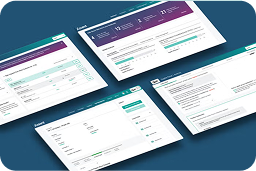The global regulatory landscape is continuously evolving, and Q4 2025 stands out as a critical period for compliance managers. Between expanding extended producer responsibility (EPR) packaging rules, new PFAS restrictions, and the EU Deforestation Regulation, staying ahead of the curve is essential to avoiding penalties and ensuring uninterrupted operations.
This blog post explores some of these key regulatory updates and outlines actionable steps that can help you stay compliant over the coming months. It includes clips from our quarterly regulatory forecast webinar series. Be sure to check out our upcoming expert webinars so you can join the next one live.
Extended Producer Responsibility (EPR) in California: Reporting Deadline Approaching
Emerging EPR requirements are a critical consideration for manufacturers, particularly those operating in California. Under SB 54, manufacturers now hold greater responsibility for the life cycle management of their packaging, including its recycling and disposal.
Mark Your Calendar: Upcoming Deadline
The next reporting date for packaging EPR under California’s SB 54 is November 15, 2025.
Next Steps
- Collaborate with suppliers: Work closely with your supply chain to collect accurate packaging material data. Assent’s EPR Packaging software can streamline this process for you.
- Complete your reporting: Ensure you gather, verify, and submit all necessary EPR data by the deadline.
PFAS: Phase-Out Risks & TSCA Amendments
PFAS restrictions are expanding globally, driven by mounting environmental and health concerns. Some major chemical manufacturers, like 3M, are phasing out products containing PFAS to avoid the legal and compliance risks associated with them. This will have a significant ripple effect across supply chains.
Additionally, with regards to TSCA Section 8(a)(7), recent amendments extended the reporting deadline and sought to reduce the reporting burden on manufacturers. Despite the extension, in-scope companies must act fast to do their due diligence and collect the necessary data to comply.
Next Steps
- Evaluate supply chain exposure: Examine components, coatings, and substances used in your products to identify whether PFAS are present.
- Prepare for redesigns: Consider alternative materials to replace PFAS and mitigate disruptions.
- Stay informed: Monitor regulatory developments in key markets like California, the EU, and the broader U.S. to update internal processes accordingly.
- Prepare for historic reporting: TSCA regulations require reporting historic data dating back to January 2011, which can be time-intensive. Start collecting this data as early as possible.
- Review upcoming proposals: Stay abreast of EPA amendments, as further changes may reduce compliance burdens for smaller manufacturers and article importers.
Protect your business by downloading our free resource, Avoiding PFAS Obsolescence Action Plan: Your Checklist for Success.
Trade Compliance & Tariffs
Trade compliance is shifting fast. Tariff actions (e.g., Section 232) are expanding coverage and raising costs, while enforcement is tightening around country of origin (COO), routing, and entity restrictions. Compliance managers should focus on correct HTS classification, accurate COO determination (including melt/cast for metals), and forced labor risks that can cause detention of goods even when duties are paid.
Next Steps
- Assess tariff exposure: Review your current import/export portfolio to identify products and/or materials subject to new or increased tariffs.
- Validate classifications: Reconfirm HTS codes, COO data, and supplier declarations to ensure accuracy and compliance.
- Monitor trade actions: Stay current on Section 232/301 updates, new investigations, and retaliatory measures that may affect key materials.
- Plan for cost impact: Model tariff scenarios and build flexibility into sourcing and pricing strategies to mitigate sudden cost increases.
- Strengthen documentation: Ensure audit-ready trade and sourcing records are available to avoid penalties or shipment delays during customs reviews.
EU Deforestation Regulation (EUDR: New Due Diligence Requirements
The EU Deforestation Regulation targets companies using commodities associated with deforestation risks, such as palm oil, soy, cattle, and timber. The compliance deadline for this regulation is set for December 2025, which means compliance managers must urgently act to meet due diligence requirements.
Next Steps
- Map your supply chain: Identify suppliers linked to deforestation-prone commodities and locations that fall under EUDR’s scope.
- Implement due diligence programs: Start gathering proof of compliance, such as documentation around responsible sourcing and certification.
- Leverage technology solutions: Consider tools that enable cross-border tracking and verification of compliance data.
EU Batteries Regulation (EUBR): Sustainability Across the Life Cycle
The EU Batteries Regulation reflects the EU’s sustainability agenda, covering a battery’s entire life cycle from production to disposal. Key compliance measures include carbon footprint disclosures, material origin tracking, and sustainability certifications. Battery passports will be required by February 2027. However, the supply chain due diligence reporting requirement in the original regulation has been pushed back to August 2027 as the EU sets up the notified bodies required to review submitted data.
Action Steps:
- Develop sustainability reports: Begin outlining how your operations comply with life cycle sustainability goals for batteries.
- Build compliance frameworks: Organize internal teams to prepare for due diligence, reporting, and material origin tracking.
- Partner with suppliers: Use this time to engage and educate your suppliers. Collecting and validating data will take longer than you think, so start now.
Practical Steps for Compliance Managers
With so many requirements to manage, it can be difficult to know where to start. But there are several strategic steps compliance managers can take to shift from chaos to proactive compliance:
- Invest in compliance software: Assent’s solutions offer robust tools for managing supplier data, reporting requirements, and risk exposure, enabling a faster, more accurate compliance process.
- Engage your suppliers: As the regulatory environment grows increasingly complex, close collaboration with suppliers is crucial for accurate data collection and real-time updates.
- Monitor changes closely: Regulations evolve rapidly, so staying informed through webinars, legislative updates, and expert insights is essential for adapting your compliance practices. Assent’s experts help ensure our customers are always informed and proactive when it comes to regulatory changes.
- Focus on high-risk areas: Prioritize high-impact areas such as PFAS phase-out, packaging regulations, and new EU product sustainability laws to mitigate potential disruptions and financial penalties.
Conclusion: Stay Proactive
To keep pace with global compliance in 2025, you need a cohesive approach to understanding your requirements, managing your data, and collaborating with your suppliers. With extended deadlines on regulations like EUBR and TSCA reporting, compliance managers like you now have an invaluable opportunity to strengthen your processes and avoid future pitfalls.
Want to simplify your compliance journey? Speak to one of our supply chain sustainability management experts to learn how we can protect your organization from financial and operational risks while helping you achieve long-term compliance success.
Watch the on-demand version of our quarterly regulatory forecast webinar at any time.
FAQ: Upcoming Regulatory Challenges for Global Manufacturers
Get expert insights on upcoming regulatory deadlines and challenges from Assent’s team of experts.







